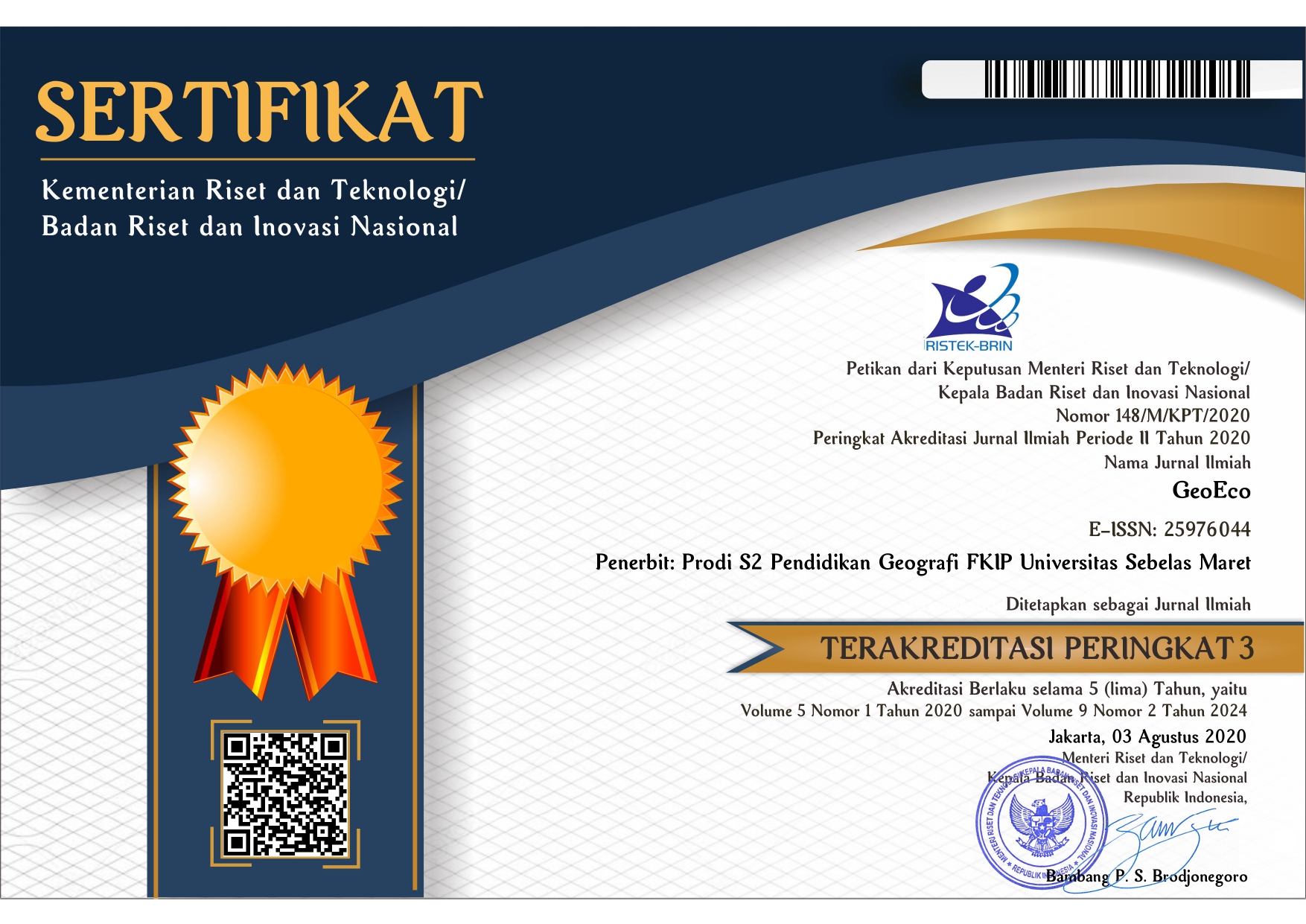GEOGRAPHICAL INFORMATION SYSTEM BASED COVID-19 VULNERABILITY MAPPING IN PONTIANAK REGENCY WEST KALIMANTAN
Abstract
2020 was the start of the toughest year for the world community in general, especially Indonesia in the health sector. The outbreak of the Covid-19 case in various regions requires clear and accurate information in efforts to deal with this pandemic. This study aims to spatially map the vulnerability of COVID-19 based on Geographic Information Systems (GIS). The method d used is a weighted overlay. The data used are population (P), population density (PD), elderly (EP), school students (SS), and hospital beds (HB). The analysis s used is a spatial analysis using ArcGIS 10.8. The results of the study show that North Pontianak District has a very high vulnerability to COVID-19. West Pontianak District and Pontianak City have high vulnerability. South and East Pontianak sub-districts have moderate vulnerability. For Pontianak Tenggara District, the level of vulnerability to COVID-19 is very low. The vulnerability to COVID is very low in Southeast Pontianak District because it has the smallest population, low density, few elderly people, few school-age children, and lots of hospital beds. An information system is an effective tool in conveying information on the spatial distribution of the level of vulnerability of Covid-19 in an area, so that steps and handling policies can be taken according to existing priorities.
Keywords
Full Text:
PDFReferences
Acharya, R., & Porwal, A. (2020). A vulnerability index for the management of and response to the COVID-19 epidemic in India: an ecological study. The Lancet Global Health, 8(9), e1142–e1151.
Armitage, R., & Nellums, L. B. (2020). COVID-19 and the consequences of isolating the elderly. The Lancet Public Health, 5(5), e256.
Awad, O., & Abu Harb, S. (2020). Palestinian Census 2017–Harnessing the Modernization Initiative. Statistical Journal of the IAOS, 36(1), 77–81.
Blaikie, P., Cannon, T., Davis, I., & Wisner, B. (1994). At risk. Natural Hazards, People’s Vulnerability and Disasters.
Castagna, F., Xue, X., Saeed, O., Kataria, R., Puius, Y. A., Patel, S. R., Garcia, M. J., Racine, A. D., Sims, D. B., & Jorde, U. P. (2022). Hospital bed occupancy rate is an independent risk factor for COVID-19 inpatient mortality: a pandemic epicentre cohort study. BMJ Open, 12(2), e058171.
CDC. (2020a). COVID-19 Provisional Counts - Weekly Updates by Select Demographic and Geographic Characteristics. National Center for Health Statistics (2020). Available online at: https://www.cdc.gov/nchs/nvss/vsrr/covid_weekly/index.htm (accessed October 4, 2020).
CDC. (2020b). Preparing for COVID-19 in Nursing Homes. Available online at: https://www.cdc.gov/coronavirus/2019-ncov/hcp/long-term-care.html (accessed December 25, 2022).
Chen, D., Hu, C., Su, F., Song, Q., & Wang, Z. (2020). Exposure to SARS-CoV-2 in a high transmission setting increases the risk of severe COVID-19 compared with exposure to a low transmission setting? Journal of Travel Medicine, 27(5), taaa094.
Chen, K., & Li, Z. (2020). The spread rate of SARS-CoV-2 is strongly associated with population density. Journal of Travel Medicine, 27(8), taaa186.
Chretien, J.-P., George, D., Shaman, J., Chitale, R. A., & McKenzie, F. E. (2014). Influenza forecasting in human populations: a scoping review. PloS One, 9(4), e94130.
Cox, R., Sanchez, J., & Revie, C. W. (2013). Multi-criteria decision analysis tools for prioritising emerging or re-emerging infectious diseases associated with climate change in Canada. PloS One, 8(8), e68338.
Cruz, K. Q. (2021). How Did COVID-19 Affect High School Students?https://aiteedge.com/911/school-news/how-did-covid-19-affect-high-school-students/. Accesed December 25, 2022.
Gralinski, L. E., & Menachery, V. D. (2020). Return of the Coronavirus: 2019-nCoV. Viruses, 12(2), 135.
Holand, I. S., Lujala, P., & Rød, J. K. (2011). Social vulnerability assessment for Norway: A quantitative approach. Norsk Geografisk Tidsskrift-Norwegian Journal of Geography, 65(1), 1–17.
Ilardi, A., Chieffi, S., Iavarone, A., & Ilardi, C. R. (2020). SARS-CoV-2 in Italy: population density correlates with morbidity and mortality. Japanese Journal of Infectious Diseases, JJID-2020.
Kanga, S., Meraj, G., Farooq, M., Nathawat, M. S., & Singh, S. K. (2021). Analyzing the risk to COVID‐19 infection using remote sensing and GIS. Risk Analysis, 41(5), 801–813.
Kodera, S., Rashed, E. A., & Hirata, A. (2020). Correlation between COVID-19 morbidity and mortality rates in Japan and local population density, temperature, and absolute humidity. International Journal of Environmental Research and Public Health, 17(15), 5477.
Kontis, V., Bennett, J. E., Rashid, T., Parks, R. M., Pearson-Stuttard, J., Guillot, M., Asaria, P., Zhou, B., Battaglini, M., & Corsetti, G. (2020). Magnitude, demographics and dynamics of the effect of the first wave of the COVID-19 pandemic on all-cause mortality in 21 industrialized countries. Nature Medicine, 26(12), 1919–1928.
Kraemer, M. U. G., Yang, C.-H., Gutierrez, B., Wu, C.-H., Klein, B., Pigott, D. M., Du Plessis, L., Faria, N. R., Li, R., & Hanage, W. P. (2020). The effect of human mobility and control measures on the COVID-19 epidemic in China. Science, 368(6490), 493–497.
Lancet, T. (2020). Redefining vulnerability in the era of COVID-19. Lancet (London, England), 395(10230), 1089.
Malczewski, J. (1999). GIS and multicriteria decision analysis. John Wiley & Sons.
Martins-Filho, P. R. (2021). Relationship between population density and COVID-19 incidence and mortality estimates: A county-level analysis. Journal of Infection and Public Health, 14(8), 1087.
Meraj, G., Farooq, M., Singh, S. K., Romshoo, S. A., Nathawat, M. S., & Kanga, S. (2021). Coronavirus pandemic versus temperature in the context of Indian subcontinent: a preliminary statistical analysis. Environment, Development and Sustainability, 23(4), 6524–6534.
Mollalo, A., Vahedi, B., & Rivera, K. M. (2020). GIS-based spatial modeling of COVID-19 incidence rate in the continental United States. Science of the Total Environment, 728, 138884.
Organization, W. H. (2020). Coronavirus disease 2019 ( COVID-19): situation report, 94.
Palaiologou, P., Ager, A. A., Nielsen-Pincus, M., Evers, C. R., & Day, M. A. (2019). Social vulnerability to large wildfires in the western USA. Landscape and Urban Planning, 189, 99–116.
Phiri, D., Salekin, S., Nyirenda, V. R., Simwanda, M., Ranagalage, M., & Murayama, Y. (2021). Spread of COVID-19 in Zambia: An assessment of environmental and socioeconomic factors using a classification tree approach. Scientific African, 12, e00827.
Roberts, M. (2020). Coronavirus: “Segment And Shield” Way to Lift UK Lockdown Now. BBC News (2020). Available online at: https://www.bbc.com/news/health-52542108 (accessed December 25, 2022).
Rufat, S., Tate, E., Burton, C. G., & Maroof, A. S. (2015). Social vulnerability to floods: Review of case studies and implications for measurement. International Journal of Disaster Risk Reduction, 14, 470–486.
Saaty, T. L. (1980). The analytic hierarchy process (AHP). The Journal of the Operational Research Society, 41(11), 1073–1076.
Sangiorgio, V., & Parisi, F. (2020). A multicriteria approach for risk assessment of Covid-19 in urban district lockdown. Safety Science, 130, 104862.
Shadeed, S., & Alawna, S. (2021). GIS-based COVID-19 vulnerability mapping in the West Bank, Palestine. International Journal of Disaster Risk Reduction, 102483.
Suppawittaya, P., Yiemphat, P., & Yasri, P. (2020). Effects of social distancing, self-quarantine and self-isolation during the COVID-19 pandemic on people’s well-being, and how to cope with it. International Journal of Science and Healthcare Research, 5(2), 12–20.
WHO. (2020). Coronavirus disease (COVID-19) Situation Report 174.
WHO. (2021). Coronavirus (COVID-19) Dashboard: Global Situation . https://covid19.who.int.
Wong, D. W. S., & Li, Y. (2020). Spreading of COVID-19: Density matters. Plos One, 15(12), e0242398.
Wu, J., Mamas, M. A., Mohamed, M. O., Kwok, C. S., Roebuck, C., Humberstone, B., Denwood, T., Luescher, T., De Belder, M. A., & Deanfield, J. E. (2021). Place and causes of acute cardiovascular mortality during the COVID-19 pandemic. Heart, 107(2), 113–119.
Zhuang, Z., Cao, P., Zhao, S., Han, L., He, D., & Yang, L. (2021). The shortage of hospital beds for COVID-19 and non-COVID-19 patients during the lockdown of Wuhan, China. Annals of Translational Medicine, 9(3).
Refbacks
- There are currently no refbacks.












.png)

